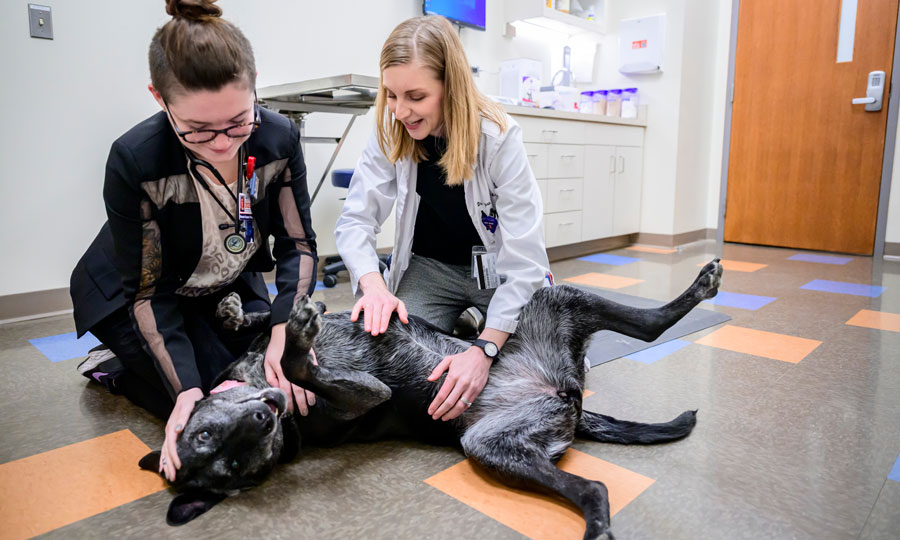Seizures have a wide variety of causes
Seizures in pets can be scary for pet owners. Knowing what seizures look like and what to do when they occur can help put pet owners at ease. Dr. Devon Hague, a veterinary neurologist at the University of Illinois Veterinary Teaching Hospital in Urbana, sees multiple patients every day that have had seizures.
“There are several different types of seizures that can range in duration, frequency, and severity,” Dr. Hague says. Generalized seizures are usually the easiest to recognize; in these seizures, the animals will lose consciousness and may fall to the side and have uncontrolled motor activity (in other words, whole-body tremors). During the seizure, pets may urinate or defecate.
Dr. Hague explains that, just as a limp can indicate a broken leg, a seizure is a manifestation of brain disease.
Any Animal Can Have a Seizure
Any animal that has a brain has the potential to have seizures. Dr. Hague, like most veterinary neurologists, typically sees cats and dogs. At the University of Illinois, the neurology and neurosurgery service also consults on exotic pets (including birds, reptiles, and small mammals) and large animal patients.
“Some pets will vocalize during a seizure, and pet owners may be concerned that their pets are in pain,” Dr. Hague says. “Although we cannot ask our animal patients how they feel, we know from asking human epileptic patients that seizures generally do not cause pain.” The animal may vocalize because they are not conscious rather than because they are in pain.
During a Seizure
Although you may feel alarmed when a seizure occurs in your pet, remaining calm is the best way to help. You must take steps to protect both yourself and your pet, because during a seizure your pet loses consciousness.
“Make sure to keep hands away from the animal’s face to avoid being bitten, and keep the animal away from stairs or anywhere that could lead to a fall and injury,” Dr. Hague advises.
It is also important to note the behaviors before, during, and after the seizure episode as well as the length of the seizure. A video of the episode will help your veterinarian make an accurate diagnosis.
When to Go to the Veterinarian
How long the seizures last indicate how quickly the pet must be seen by a veterinarian. If the seizure lasts 5 minutes or more, or if the animal experiences more than two seizure episodes within 24 hours, then the pet should see a veterinarian right away. If the pet cannot get an appointment with the primary care veterinarian, owners should take the pet to an emergency hospital because of the seriousness of this situation.
“These scenarios are cause for alarm because with each seizure that occurs, it becomes easier to have another one and harder to stop them,” Dr. Hague explains. Prolonged seizures can cause the body to overheat and cause serious damage to the animal.
Your family veterinarian may refer your pet to a specialty hospital, such as the University of Illinois Veterinary Teaching Hospital, if further diagnostics or a second opinion is needed.
Seizures could indicate a wide variety of disorders. In making a diagnosis, the veterinarian takes into consideration the animal’s history, age, and findings of the neurological examination. The neurological examination examines the pet’s mental status, gait and posture, the function of the cranial nerves, postural reactions, and spinal reflexes. Each of these components helps the veterinarian determine what the issue is and where it is located.
Treatment and Prevention
“Treatment of seizures can vary depending on the cause and the particulars of the case,” Dr. Hague says. Medications are available to reduce the number and frequency of the seizure episodes. The veterinarian will look at the side effects and the efficacy of the medication and recommend the best option for the patient.
“One of the easiest ways to prevent seizures is to routinely have the pet vaccinated,” Dr. Hague stresses. Vaccinations help prevent certain diseases, such as canine distemper virus or rabies, that can cause neurologic symptoms, such as seizures.
Seizures may also occur in conjunction with other diseases, such as stroke, cancer, toxicity, and inflammatory diseases. Owners should feel assured that their pet’s seizures are not the owners’ fault.
For more information about seizures, contact your local veterinarian.
By Beth Mueller
Photo by L. Brian Stauffer

![[Dr. Devon Hague with patient]](https://vetmed.illinois.edu/wp-content/uploads/2021/04/pc-seizures-hague.jpg)


